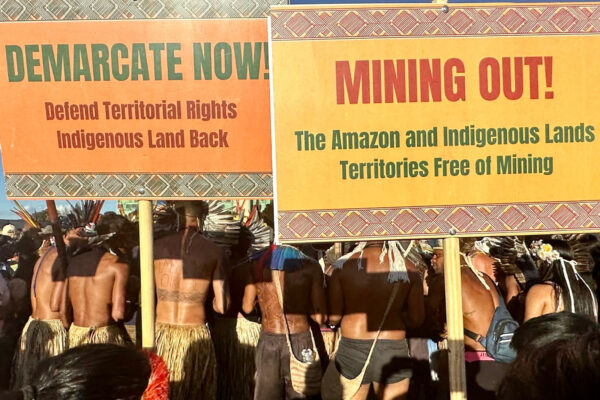
Ensuring forest people’s land rights in the Amazon region is a cheap and effective way of cutting both carbon emissions and deforestation, researchers say – but the obstacles are formidable.
A report from the World Resources Institute (WRI) offers new evidence that the modest investments needed to secure these rights will generate billions of dollars in returns – economically, socially and environmentally – for governments, investors and communities.
The report, Climate Benefits, Tenure Costs, quantifies the economic value of securing land rights for the indigenous communities who live in and protect forests, with a focus on Colombia, Brazil and Bolivia in South America, and implications for the rest of the world.
Previous WRI research has found that when indigenous peoples and communities have secure rights to land, deforestation rates and carbon emissions are often significantly reduced.
In the new report, matching analysis data shows that the average annual deforestation rates in Bolivia, Brazil and Colombia were significantly lower in tenure-secure indigenous forests than in similar areas without secure tenure: 35% lower in Bolivia, 40% lower in Brazil, and 50% lower in Colombia. All three countries have large portions of the Amazon forest within their borders.
Yet although protecting indigenous land rights can help meet national emissions reduction commitments to the Paris Agreement on climate change, only 21 of 197 intended nationally determined contributions (INDCs) mention community-based land tenure, and only one sets a measurable target for the expansion of secure tenure rights.
Land grabbers
In Brazil itself, there is mounting pressure from ranchers, loggers and land grabbers who are invading indigenous areas, whether they are officially recognised or not.
Based on satellite images from Brazil’s National Institute for Space Research (INPE), which monitors the Amazon region, the National Indian Foundation (FUNAI) has just issued a warning on the website of the Socio-Environmental Institute (ISA) that, as a result of that pressure, deforestation inside indigenous reserves is rising.
The images show that between January and September this year, an area of 188,000 sq km was cleared – the equivalent of around 25,000 football fields. This is almost three times the 67,000 sq km deforested in the whole of 2015.
Together, the 419 indigenous areas located within the Brazilian Amazon region cover more than 1 million sq km. So far, what has been cleared amounts to only 2% of the total, but non-governmental organisations fear that the barrier to the advance of agriculture, logging and land grabbers, which is formed by the existence of this mosaic of indigenous areas and conservation areas, is beginning to collapse.
Large-scale government dam building projects have also contributed to higher rates of deforestation. Cachoeira Seca, the most deforested of all the indigenous areas, is near the recently built Belo Monte hydro-electric dam.
Yet the WRI report shows that the modest investments needed to secure land rights for indigenous peoples in the Amazon could generate billions of dollars in economic, social and environmental returns for governments, investors and communities.
The total estimated benefits of securing indigenous lands in Brazil are US$523bn–$1,165tn, in Bolivia $54–$119bn, and in Colombia $123–$277bn over the next 20 years, after factoring in global carbon benefits and ecosystem conservation.
“We now know that there is a clear economic case to be made for ensuring that indigenous peoples have secure rights to their land,” says Andrew Steer, president and CEO of WRI. “Not only is securing land tenure the right thing to do, it’s one of the world’s most cost-effective climate mitigation strategies.
“National governments should take note – and move quickly – to secure indigenous lands and incorporate land rights into their climate change strategies and commitments to the Paris Agreement.”
Securing land rights
The WRI reckons that the cost of securing indigenous land rights in the Amazon is just a few dollars per hectare of forest per year – less than 1% of the total economic benefits. The report also finds that securing indigenous and community lands is cost-effective when compared with other climate mitigation options such as carbon capture and storage (CCS).
Analysis shows that using CCS to reduce emissions costs 5-29 times more in coal-fired power plants and 7-42 times more in natural gas-fired power plants than achieving the same emissions reductions through securing indigenous forestland tenure. And CCS technology has yet to be proved workable at scale.
“Indigenous peoples and local communities have a long history of using natural resources wisely and adapting to the changing climate in an integrated and sustainable manner,” says Naoko Ishii, CEO and chair of the Global Environment Facility (GEF).
“Protecting and enhancing the land rights of indigenous peoples is a necessary step towards greater economic prosperity and safeguarding our global commons.”
Unfortunately, policymakers in Brazil continue to ignore the benefits of preserving indigenous lands, even when they are so clearly spelled out.
Instead, FUNAI’s funding – and therefore its ability to protect indigenous areas – has been drastically cut under the recent tough austerity measures introduced by the federal government to tackle economic recession. And if the WRI report is right, this is in every sense a false economy.













